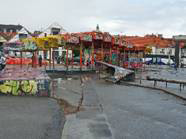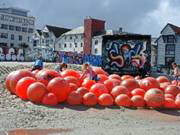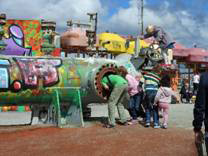August 2, 2016 Stavanger, Norway At last, a real city. It was raining.
The guide was from London originally and great fun. She introduced herself as speaking three languages; English, gibberish, and rubbish, and promised to speak all three during the tour.
The Petroleum Museum was a place I wasn't particularly interested in seeing. I am not a museum buff. So I broke away from the group and went to a nearby shopping street to try to find some Nordic trekking poles. (Would you believe that I've looked for those trekking poles in at least three of our last stops and just cannot find them.) On the way back I passed by a children's playground (the photos below). It's part of the Museum and the playground "equipment" is cleaned-up and repurposed scrap parts from oil drilling rigs. In addition to the imaginative use of the materials, graffiti artists were encouraged to paint the pieces in bright colors. The children loved it all and were using this playground even in the rain. I returned in time to join the tour through part of the Museum, which I must confess was more interesting than I expected. The building, exhibits and interactive displays, videos, etc., are testimony to what can be done if money is no object. Starting in the 1070's Norway became very wealthy from oil and this Museum shows it.    We returned to the ship, had lunch, and decided to take a chance that the sunshine that had broken through in the late morning. The remainder of the downtown is wrapped around a small harbor in a fjord. The whole harbor area is home to the ships and storage Stavanger is a nicely laid out, comfortable, midsize affluent city. Regarding affluence, however, there's been a recent turn of events. Over the last 18 months or so, falling oil prices around the world led to reduced oil production resulting in lower revenues and the loss of jobs for about 30,000 workers in the Norwegian oil industry (who are considered very well paid in this country). Many of those workers live in and around Stavanger. We have pulled away from port and are at sea for the next two nights and the day in between. We dock at Dover, England and begin our journey home. We just passed one of the oil rigs. Big things. And it wasn't even in the North Sea. It has been a pleasant trip. We are getting better at traveling, packing less and planning more carefully. Although Carol did not see a Viking (as far as I know) we both had a good time visiting the places she has long wanted to see. |